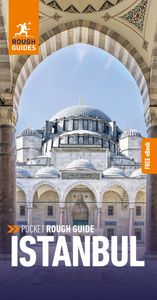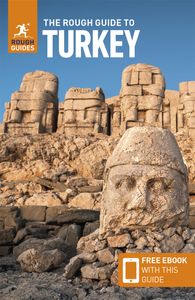Amasya
Occupying the narrow valley of the Yeşilırmak River, and blessed with a super-abundant historical legacy, AMASYA is one of the high points of northern Anatolia. Most visitors come to see the rock tombs hewn into the cliffs above the town by the kings of Pontus, over two thousand years ago, but Amasya also harbours some truly beautiful Selçuk and Ottoman architecture, and a multitude of restored nineteenth-century wooden houses. Many of the latter are now authentic and atmospheric antique shops, pansiyons and restaurants, in keeping with the general Ottoman theme.
Brief history
Amasya was once part of Pontus, one of several small kingdoms to spring up following the death of Alexander the Great, which survived for two hundred years. Its downfall began when Mithridates VI Eupator reputedly ordered the massacre of eighty thousand Romans in a single day and plunged his kingdom into a series of wars, which culminated in its being absorbed by Pompey into the Roman sphere of influence around 70 BC.
Under the Romans, and through the succeeding centuries of Byzantine rule, the town prospered, and it continued to do so after falling to the Selçuks in 1071. In the late thirteenth century, Amasya became part of the burgeoning Ottoman state. It became a training ground for crown princes, who would serve as governors of the province to prepare them for the rigours of statesmanship at the Sublime Porte. Amasya then became a vital staging post en route to the creation of modern Turkey: it was here that, on June 21, 1919, Atatürk delivered a speech that was in effect a call to arms for the coming War of Independence.
Getting steamy in Amasya
Amasya boasts a couple of wonderfully atmospheric hamams, each of them centuries old – stay here a few days and you’ll be able to take them in at your leisure.
Sıhhı Mustafa Bey Hamamı
Mustafa Kehal Bul. Sandwiched between a mosque, a museum and the river, this hamam is very old but very much in use, as the wreaths of vapour emerging from its chimneys testify. Entry TL12.5, same again for massage. Daily: men 7–10am & 5–11pm; women 10am–5pm.
Yıldız Hamamı
On the north bank, next to the Hazeranlar Konağı. According to the plaque outside, this hamam was constructed “in the mid’s of the 13th contray and rebult in the 16th countruy”. Mercifully the interior beats the spelling hands down. Entry TL12.5, TL6 extra for a sponge-down or massage. Daily 6am–midnight.
The rock tombs
The massive tombs of the Pontic kings are carved into the cliff-face on the northern bank of the Yeşilırmak – there’s little to see bar the holes, although the city views from here are absolutely spellbinding. Note that the paths can be a little slippery, and not all have fences to guard against falls; as well as bringing decent footwear, in summer you’re advised to visit in the evening, when the cliffside is in welcome shadow.
There are two main clusters of tombs. Where the path splits above the entrance, bearing left will bring you to two large tombs; beside the entrance to one of them is the mouth of a tunnel, thought to lead to the river. Bearing right instead, then passing the café, will bring you to a less accessible group slightly sullied by graffitied love declarations. More tombs can be found with a bit of effort – there is a total of eighteen throughout the valle
Divriği
Stuck in the middle of a mountainous nowhere, on a hill overlooking a tributary of the young Euphrates, sleepy DIVRIĞI merits a visit for the sake of a single monument – the whimsical and unique Ulu Cami and its dependency, the Darüşşifa. These date from the early thirteenth century, when the town was the seat of the tiny Mengüçeh emirate. The Mongols, who evicted the Mengüçehs in 1252, demolished the castle but left the religious foundations alone, and the place was not incorporated into the Ottoman Empire until 1516.
Divriği retains a ramshackle bazaar area, crisscrossed by cobbled lanes and grapevines. It also sports distinctive wooden minarets and old houses with inverted-keyhole windows, neither of which are seen elsewhere in Anatolia. The conspicuous mosque and sanitorium, joined in one complex at the top of a slope 250m east of town, command a fine view.
Hittite sites
The Hittite sites centred on the village of Boğazkale, 150km east of Ankara, are the most impressive and significant in the whole of Anatolia, and are appropriately located amid rolling countryside that has changed little through the centuries.
This area was once the heart of the Hittite Empire, with Hattuşa, spread south of the modern village, as its capital. The temple site of Yazılıkaya is a few kilometres east, while remote Alacahöyük, 25km north, is worth the trip if you have your own transport.
Excavation on these sites began in earnest in 1905, and many of the objects unearthed are now housed in Ankara’s Museum of Anatolian Civilizations. If you’ve already seen the museum, a visit to the original excavations is doubly interesting; if not, a quick visit to the new archeological museum in nearby Çorum is definitely worthwhile.
Hattuşa
Enclosed by 6km walls, Hattuşa was, by the standards of its era, an immense city, and its scale is still awe-inspiring today. The site, on a steeply sloping expanse dotted with rocky outcrops, was originally occupied by the Hatti, who established a settlement here around 2500 BC. The Hittites moved in after their conquest of central Anatolia, and made it their capital from about 1375 BC onwards, as their empire was reaching its greatest extent.
Archeologists unearthed the Hittite city during the first half of the nineteenth century. Of the numerous buildings once scattered over a wide area, only the limestone foundation blocks survive. The vulnerable upper parts, originally consisting of timber frames supporting clay brick walls, have long since vanished.
The Büyük Mabet
The largest and best-preserved Hittite temple to survive at Hattuşa, the Büyük Mabet, or “Great Temple”, stands immediately beyond the ticket office. Built around the fourteenth or thirteenth century BC, and one of an original seventy on the site, it was dedicated to the storm god Teshuba and the sun goddess Hebut. It consisted of a central temple building, surrounded by 78 storage rooms laid out in an irregular plan.
You approach it between two large stone blocks, remnants of the ceremonial gateway. A stone lion nearby originally formed part of a cistern, while a large, green cubic stone a little further on was reputedly a wedding present from Ramses II of Egypt, who married a Hittite princess. In Hittite times the king and queen, in their roles as high priest and priestess, would have led processions through here on holy days. Most visitors now follow the same route, along a clearly defined processional way of uneven slabs.
The temple consisted of about twelve small chambers around a central courtyard, with the rooms that would have contained the cult statues of Teshuba and Hebut at the northeastern end – the god on the left and the goddess on the right.
Just below the Büyük Mabet, archeologists have identified an early Assyrian merchant quarter. This held the Hittite equivalent of the Rosetta Stone, a parallel Hittite hieroglyph and Akkadian inscription that was instrumental in the final cracking of the hieroglyphic code, and is now in Ankara’s Museum of Anatolian Civilizations.
The Aslanlıkapı
The Aslanlıkapı, or “Lion Gate”, takes its name from the two stone lions that flank the outer entrance (one an all-too-obvious replica), symbolically guarding Hattuşa from attackers and evil spirits. It also marks the start of a surviving section of dry-stone city wall, which runs along the top of a massive sloping embankment that’s 10m in height and surfaced with irregular limestone slabs.
The Yerkapı
The Yerkapı, or “Earth Gate”, along the embankment from the Aslanlıkapı, is more popularly known as the Sphinx Gate after the two huge sphinxes that once guarded its inner portal; one returned in 2011 to the museum in Boğazkale.
The most striking feature of the Sphinx Gate is the 70m tunnel that cuts through from the city side of the walls to the exterior. It was built using the corbel arch technique, a series of flat stones leaning towards each other creating its triangular profile. Some archeologists argue that it enabled the defenders of the city to make surprise attacks on besieging enemies. Others, citing the tunnel’s obvious visibility from the outside – and the presence of two sets of monumental steps leading up the embankment – suggest that it had a more ceremonial function.
The Kralkapı
The Kralkapı, or “King’s Gate”, east of the Sphinx Gate, is named after the regal-looking figure carved in relief on the left-hand pillar of the inner gateway. This actually represents the god Teshuba, and shows him sporting a conical hat while raising his left fist in the air as though holding an invisible sword. What you see is a copy – the original is in Ankara’s Museum of Anatolian Civilizations.
The Hittites
The Hittites appear to have been an Indo-European people who moved into Anatolia around 2000 BC, and entered the territories of the indigenous Hatti. Where exactly the Hittites came from remains unclear; possibilities include the Caucasus and the Balkans. Neither do records survive of how the Hittites rose to dominance. Layers of burned material found in most Hatti settlements suggest at least some degree of violence was involved, but the Hittites also absorbed important elements of Hatti culture, so a more complex interaction may have taken place.
While Hattuşa is by far the most famous, the Hittites actually set up a number of city-states, drawn together during the mid-eighteenth century BC under King Anitta. He transferred his capital from the city of Kushara (possibly modern Alişar) to Nesha (Kültepe), and destroyed Hattuşa, cursing any Hittite king who might attempt to rebuild the place. A century or so later his successor Labarna returned to Hattuşa and did just that. The Hittites came to regard Labarna and his wife Tawannanna as founders of the Hittite kingdom, and their names were adopted as titles by subsequent monarchs.
In 1595 BC, Mursili I succeeded in capturing distant Babylon, but his successor (and assassin) Hantili lost many previous gains. Stability was restored when Tudhaliyas II re-established the Hittite state as an empire, around 1430 BC. An important period of expansion followed under King Suppiluliuma (1380–1315 BC), who secured the northern borders and conquered the Hurrian kingdom of Mitanni. This achievement raised the Hittites to superpower status, equal with Egypt, Assyria and Babylon. The Egyptians even asked Suppiluliuma to send one of his sons to marry the widow of Tutankhamun, but the boy was murdered en route, and the union never took place. Hittite expansion continued after Suppiluliuma’s death. In 1286 BC, during the reign of Muwatalli II, a Hittite army defeated the Egyptians, commanded by Ramses II, at the Battle of Kadesh. Events from the battle can be seen carved into the columns at Luxor.
Following the conflict, peace between the two empires was established, cemented by the marriage of one of the daughters of Ramses II to Hattuşiliş III. However, the Hittite Empire had less than a century left. The arrival of the Sea Peoples in Anatolia ushered in a period of instability that was to erode Hittite power, culminating in the destruction of Hattuşa around 1200 BC, at much the same time as the fall of Troy. The Phrygians replaced the Hittites as the dominant power in central Anatolia, taking over the ruins of Hattuşa and other Hittite cities.
Hittite civilization was highly advanced, with a complex social system. While the Hittite kings were absolute rulers, an assembly called the panku appears at times to have wielded considerable influence. The major division in Hittite society was between free citizens – including farmers, artisans and bureaucrats – and slaves, who, while they could be bought and sold, were probably entitled to own property and to marry.
Hittite religion seems to have been adopted from the Hatti, with the weather god Teshuba and the sun goddess Hebut as the two most important deities. As the Hittites were in the habit of incorporating the gods of conquered peoples into their own pantheon, up to a thousand lesser gods also played a role in their beliefs.






















